Cameo Communications WLG1100 802.11g WIRELESS CARDBUS ADAPTOR User Manual WLG 1100 UserMan
Cameo Communications Inc 802.11g WIRELESS CARDBUS ADAPTOR WLG 1100 UserMan
users manual
IEEE 802.11g
CardBus Adapter
User’s Guide

ii
Regulatory notes and statements
Wireless LAN, Health and Authorization for use
Radio frequency electromagnetic energy is emitted from Wireless LAN
devices. The energy levels of these emissions however are far much less than
the electromagnetic energy emissions from wireless devices like for example
mobile phones. Wireless LAN devices are safe for use frequency safety
standards and recommendations. The use of Wireless LAN devices may be
restricted in some situations or environments for example:
·On board of airplanes, or
·In an explosive environment, or
·In case the interference risk to other devices or services is perceived or
identified as harmful
In case the policy regarding the use of Wireless LAN devices in specific
organizations or environments (e.g. airports, hospitals, chemical/oil/gas
industrial plants, private buildings etc.) is not clear, please ask for
authorization to use these devices prior to operating the equipment.
Regulatory Information/disclaimers
Installation and use of this Wireless LAN device must be in strict accordance
with the instructions included in the user documentation provided with the
product. Any changes or modifications made to this device that are not
expressly approved by the manufacturer may void the user’s authority to
operate the equipment. The Manufacturer is not responsible for any radio or
television interference caused by unauthorized modification of this device, of
the substitution or attachment. Manufacturer and its authorized resellers or
distributors will assume no liability for any damage or violation of
government regulations arising from failing to comply with these guidelines.

iii
USA-FCC (Federal Communications Commission) statement
This device complies with Part 15 of FCC Rules.
Operation is subject to the following two conditions:
1. This device may not cause interference, and
2. This device must accept any interference, including interference that may
cause undesired operation of this device.
FCC Radio Frequency Exposure statement
This Wireless LAN radio device has been evaluated under FCC Bulletin OET
65 and found compliant to the requirements as set forth in CFR 47 Sections
2.1091, 2.1093, and 15.247 (b) (4) addressing RF Exposure from radio
frequency devices. The radiated output power of this Wireless LAN device is
far below the FCC radio frequency exposure limits. Nevertheless, this device
shall be used in such a manner that the potential for human contact during
normal operation is minimized.
When nearby persons has to be kept to ensure RF exposure compliance, in
order to comply with RF exposure limits established in the ANSI C95.1
standards, the distance between the antennas and the user should not be less
than 20 cm.
FCC Interference Statement
This equipment has been tested and found to comply with the limits for a
Class B digital device, pursuant to Part 15 of the FCC Rules. These limits are
designed to provide reasonable protection against harmful interference in a
residential installation.
This equipment generates, uses, and can radiate radio frequency energy. If not
installed and used in accordance with the instructions, it may cause harmful
interference to radio communications.
However, there is no guarantee that interference will not occur in a particular
installation. If this equipment does cause harmful interference to radio or
television reception, which can be determined by turning the equipment off
and on, the user is encouraged to try and correct the interference by one or
more of the following measures:

iv
1. Reorient or relocate the receiving antenna.
2. Increase the distance between the equipment and the receiver.
3. Connect the equipment to an outlet on a circuit different from that to which
the receiver is connected.
4. Consult the dealer or an experienced radio/TV technician for help.
Export restrictions
This product or software contains encryption code that may not be exported or
transferred from the US of Canada without an approved US Department of
Commerce export license.
Safety Information
Your device contains a low power transmitter. When device is transmitted it
sends out radio frequency (RF) signal.
CAUTION: To maintain compliance with FCC’s RF exposure guidelines, this
equipment should be installed and operated with minimum distance 20cm
between the radiator and your body. Use on the supplied antenna.
Unauthorized antenna, modification, or attachments could damage the
transmitter and may violate FCC regulations.
CE Mark Warning
This is a Class B product. In a domestic environment, this product
may cause radio interference, in which case the user may be required
to take adequate measures.

v
TABLE OF CONTENT
Introduction.......................................................................................... 1
Overview of this User’s Guide......................................................... 1
Unpacking and Setup ........................................................................... 3
Unpacking........................................................................................ 3
Setup ................................................................................................ 3
Hardware Installation........................................................................... 5
LED Indicator .................................................................................. 5
Check the installation....................................................................... 5
Software Installation ............................................................................ 7
Windows 98/ME/2000/XP Utility and Driver Installation............... 7
Wireless Utility Setting.................................................................... 8
Technical Specifications .................................................................... 19
Appendix A........................................................................................ 21
Regulatory Domains ...................................................................... 21

1
INTRODUCTION
Congratulations on your purchase of this IEEE 802.11g Wireless Cardbus
Adapter.
This manual helps to get familiar with the Wireless Cardbus Adapter. This
manual contains detailed instructions in operation of this product. Please keep
this manual for future reference.
With a Wireless (IEEE 802.11g) Cardbus Adapter, a laptop computer or a
station can communicate with another computer in a wireless way. Easy-to-
use utilities are bundled with Wireless Cardbus Adapter for configuration,
monitoring, and diagnosis purposes.
Wireless Cardbus Adapter can wirelessly transmit and receive data,
minimizing the need for wired connections, at a speed of up to eleven megabit
per second. With Wireless Cardbus Adapter, you can locate your Notebook
PC or station wherever you want without wires and cables.
Wireless Cardbus Adapter provides users with an access to real-time
information anywhere in their organization. The mobility provides
productivity and service, which are not available under wired networks. The
Wireless Cardbus Adapter configuration is easy to change from peer-to-peer
networks, suitable for a small number of users, to full infrastructure networks
of thousands of users that allow roaming around a broad area.
Overview of this User’s Guide
Introduction. Describes the Wireless Cardbus Adapter.
Unpacking and Setup. Helps you get started with the basic installation of the
Wireless Cardbus Adapter.
Hardware Installation. Describes the LED indicators of the Adapter.
Software Installation. Tells how to setup the driver and the utility setting.
Technical Specifications. Lists the technical (general, physical and
environmental) specifications of the Wireless Cardbus Adapter.
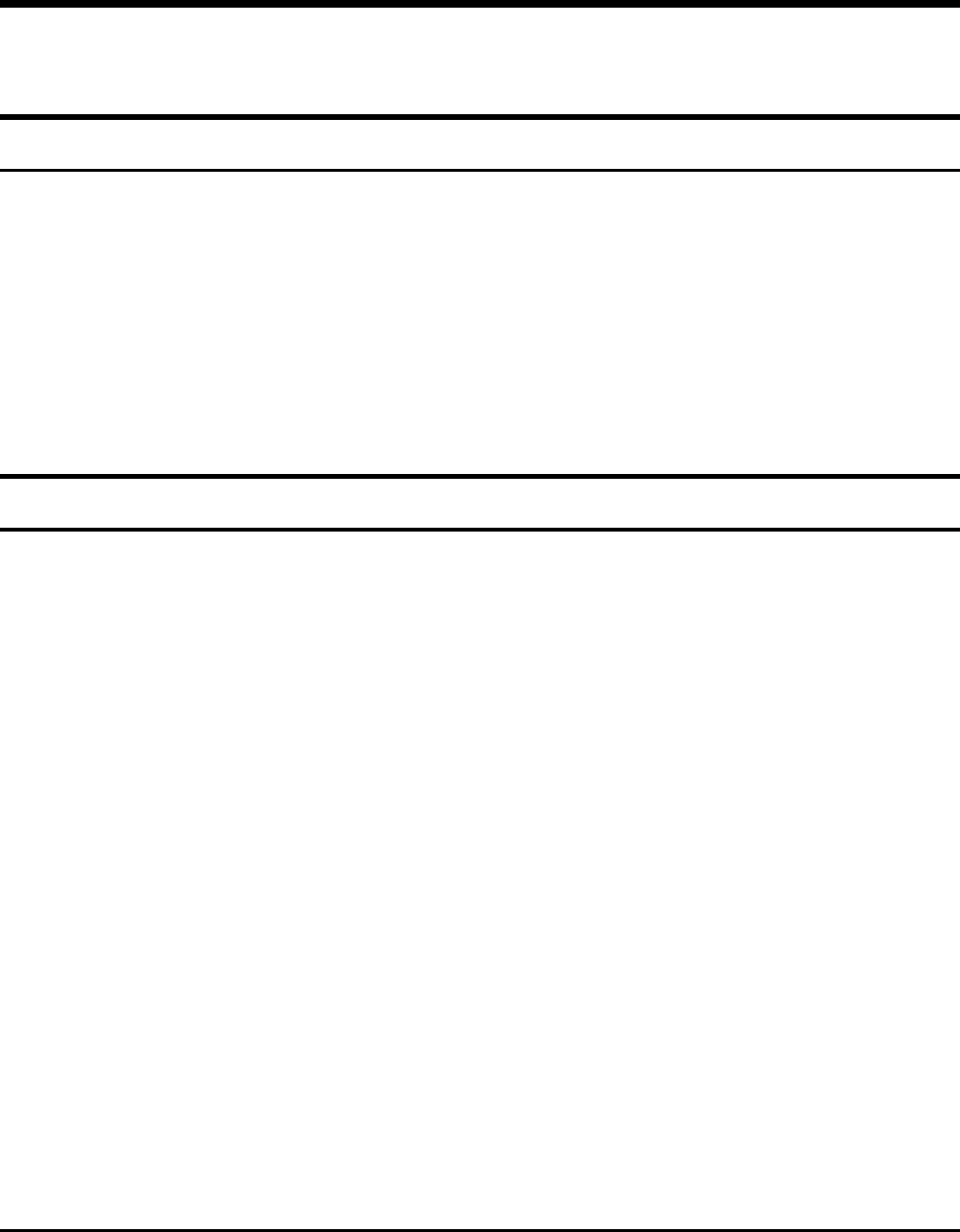
3
UNPACKING AND SETUP
This chapter provides unpacking and setup information for the
Wireless Cardbus Adapter.
Unpacking
Open the box of the Wireless Cardbus Adapter and carefully unpack it.
The box should contain the following items:
One 802.11g Wireless Cardbus Adapter
One Driver & Utility with User’s Guide CD-ROM
If any item is found missing or damaged, please contact your local
reseller for replacement.
Setup
The setup of the Wireless Cardbus Adapter can be performed using
the following steps:
Visually inspect the Cardbus Adapter and make sure that it is
fully plugged in to the Cardbus slot.
Make sure that there is a well environment that there is no much
intrusion to have a better connection.

5
HARDWARE INSTALLATION
LED Indicator
PWR (POWER)
The PWR indicator lights green when the Wireless Cardbus Adapter is
receiving power, otherwise, it is off.
LNK (LINK)
The LNK indicator blinks green when the Wireless Cardbus Adapter
is connected to a network successfully and transmitting data.
Otherwise the LNK indicator is off whiles the Wireless LAN is stand
by.
Check the installation
The LEDs of the Wireless Cardbus Adapter are clearly visible and the
status of the network link can be seen instantly:
1. Once the device is plugged to the station’s Cardbus slot, the PWR
LED of the Wireless Cardbus Adapter will light up indicating a
normal status.
2. When the device plugged to the station’s Cardbus slot and the
driver was installed, the LNK LED will start blinking, it means
that the device is starting to scan the wireless devices near the
Wireless Cardbus Adapter.
3. While the Wireless Cardbus Adapter linked up and transmitting
data to the Access Point or to other Wireless LAN station, the
LNK LED will start blinking.
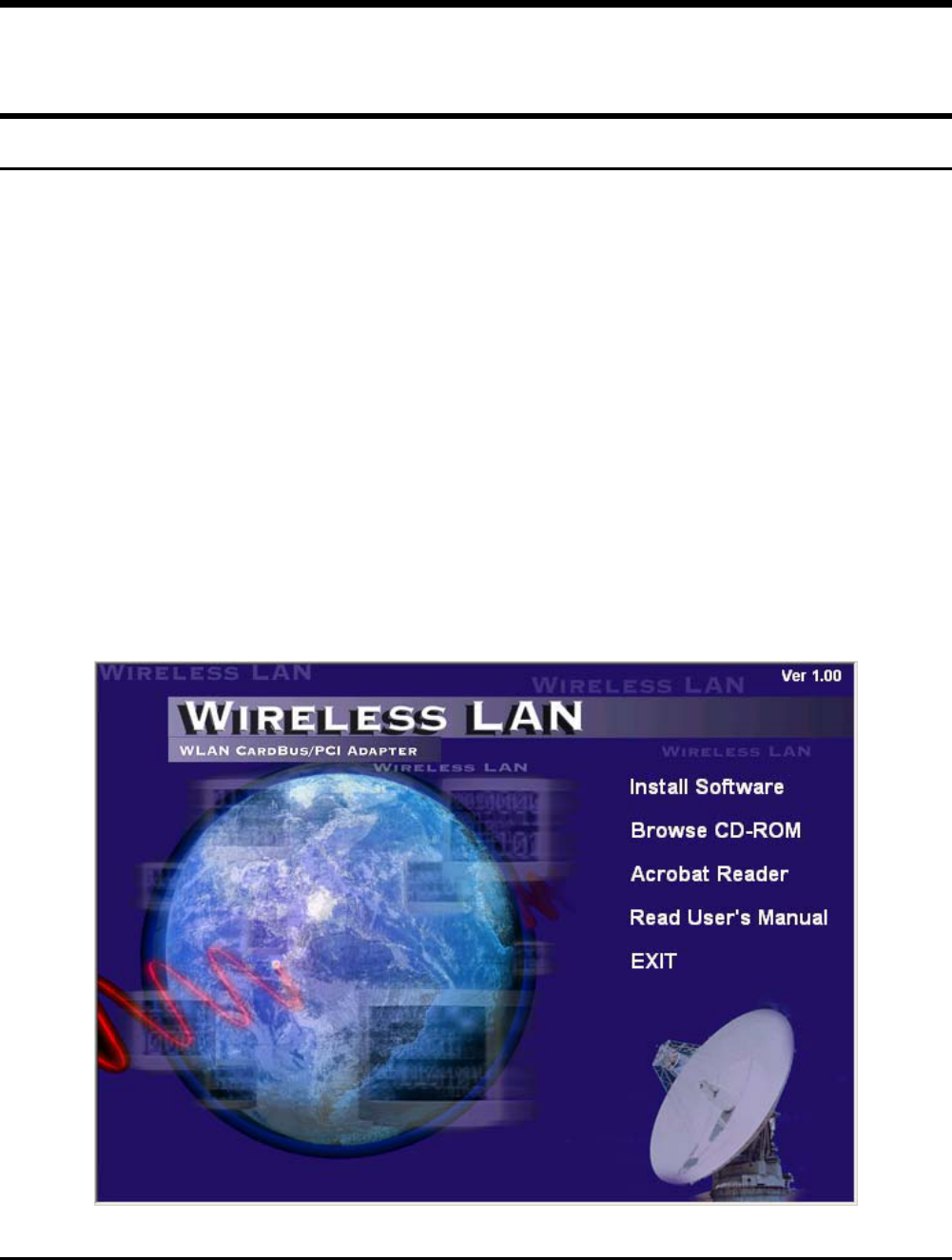
7
SOFTWARE INSTALLATION
This section will lead you to install the driver and utility of the
Wireless Cardbus Adapter.
Windows 98/ME/2000/XP Utility and Driver Installation
1. Insert the Wireless Cardbus Adapter Driver & Utility CD-ROM
into computer’s CD-ROM Drive and it will automatically run a
setup menu and install the driver and the utility. In some specific
setting on Windows system, you may need to proceed the
software manually, go to your Windows Start menu and choose
Run, type “D:\Utility\Setup.exe” in the dialog box (D:\ will
depend on where your CD-ROM drive is located) and click OK.
2. If you need to install the driver manually, refer each Windows
OS to the following CD-Rom directory path:
D:\Driver\<Windows OS>\TNET1130.inf.
Note: (D:\ will depends on where the CD-ROM drive is located and
<Windows OS> will depend on the Windows OS you are using).
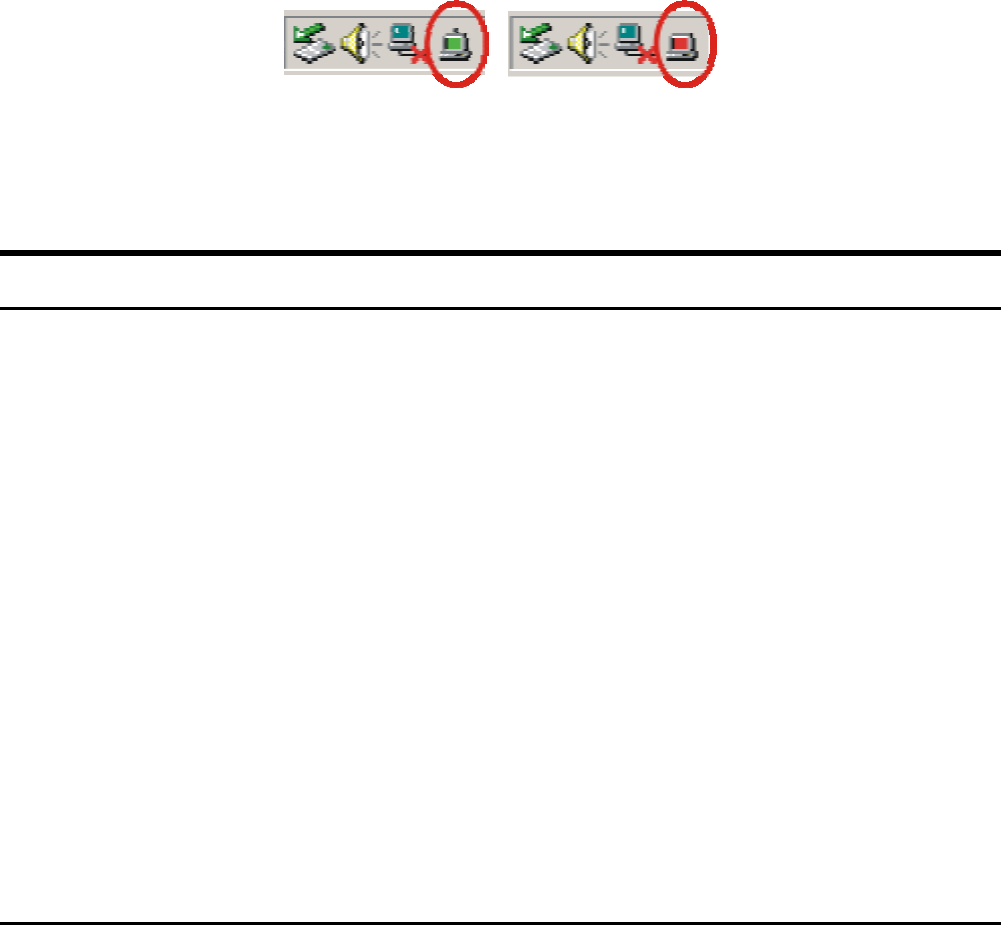
8
3. The InstallShield Wizard screen will appear. Click Next to
continue.
4. The installation program will help you to setup the Wireless
Cardbus utility.
Be noted that the Windows XP have its own Wireless Utility;
you can either use the utility of Windows XP or the provided
utility.
5. After finish the installation, plugged in the Wireless Cardbus
Adapter, you will see the icon on the Windows task bar.
When the icon in the toolbar represent in green color, it is
properly connected to the network and if it represent in red
color, then it is not connected to the network.
Wireless Utility Setting
With the Wireless Cardbus Adapter utility, users can configure all the
functions provided by the Wireless Monitor Utility. Double-click the
utility icon that appears in the taskbar.
The Wireless Monitor Utility includes seven tabs: Status,
Configuration, Advanced, Profile, Network, Statistics and About.
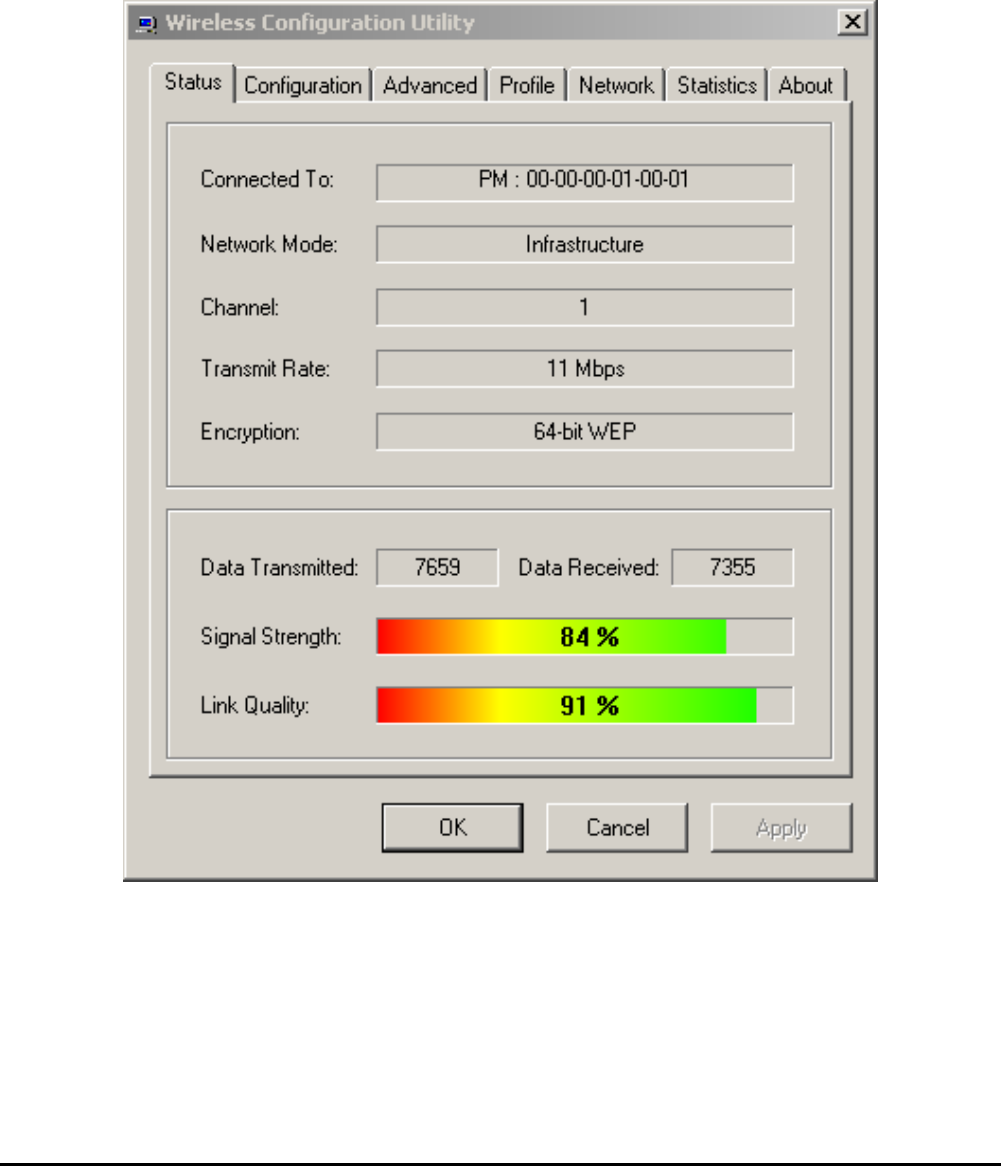
9
Status
The Status screen shows you the status of the Cardbus Adapter, it
shows that where the device is connected to, the Network mode, the
Channel, the transmit rate and the encryption mode.
There is another dialog box showing the data transmitted and data
received. The two signal lines show the Signal Strength and the Link
Quality of the device.
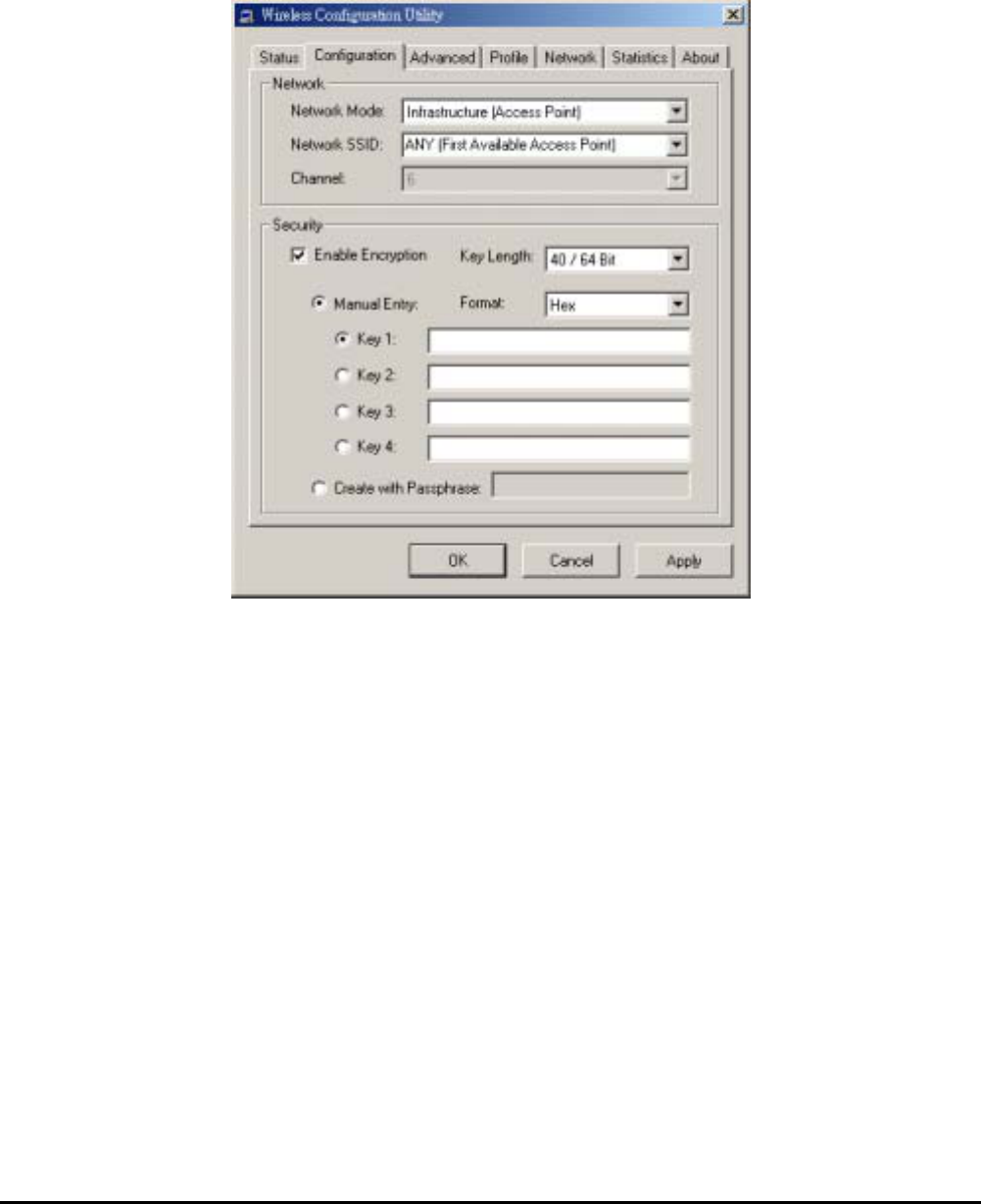
10
Configuration
The Configuration function helps you to configure the Network and
the Security.
Network: the setting of the Network mode, the SSID and the
Channels.
¾ Network Mode:
If you want to connect with an Access Point, please set to
“Infrastructure” mode. If you have more stations and just want to set
them as local network, please set the mode to “Ad-Hoc” mode.
¾ Network SSID:
The SSID differentiates one Wireless LAN group name from another;
so all access points and all devices attempting to connect to a specific
Wireless LAN group name must use the same SSID. A device will not
be permitted to join the BSS unless it can provide the unique SSID.

11
If the SSID parameter is “ANY”, it will detect the strongest signal of
the wireless station.
¾ Channel:
It shows radio channel numbers that used for Wireless LAN
networking.
The channel number can be set only under the Ad-Hoc operation
mode. In Ad-Hoc mode stations, each station must have the same
channel numbers and SSID.
In Infrastructure mode, the Wireless Cardbus Adapter will
automatically detect the channel number of the Access Point.
Security: the setting of the Network Encryption.
This function is used to protect wireless communication from
eavesdropping. A secondary function of encryption is to prevent
unauthorized access to a wireless network, and it can be achieved by
using the Encryption function.
Click the Enable Encryption to activate the security of the Cardbus
Adapter.
¾ Key Setting #1 ~ #4:
You can type the key that you want to use from Key#1 to Key #4, and
the key that you type will be the encryption between the station that
you connected with.
If you select 64bit in Hex format, you must type 10 values in the
following range (0~F, hexadecimal), or 64bit in ASCII format, you
must type 5 values in the following range (0~9, A~Z and a~z
Alphanumeric).
If you select 128bit in Hex format, you must type 26 values (0~F,
hexadecimal), or 128bit in ASCII format, you must type 13 values in
the following range (0~9, A~Z and a~z Alphanumeric).
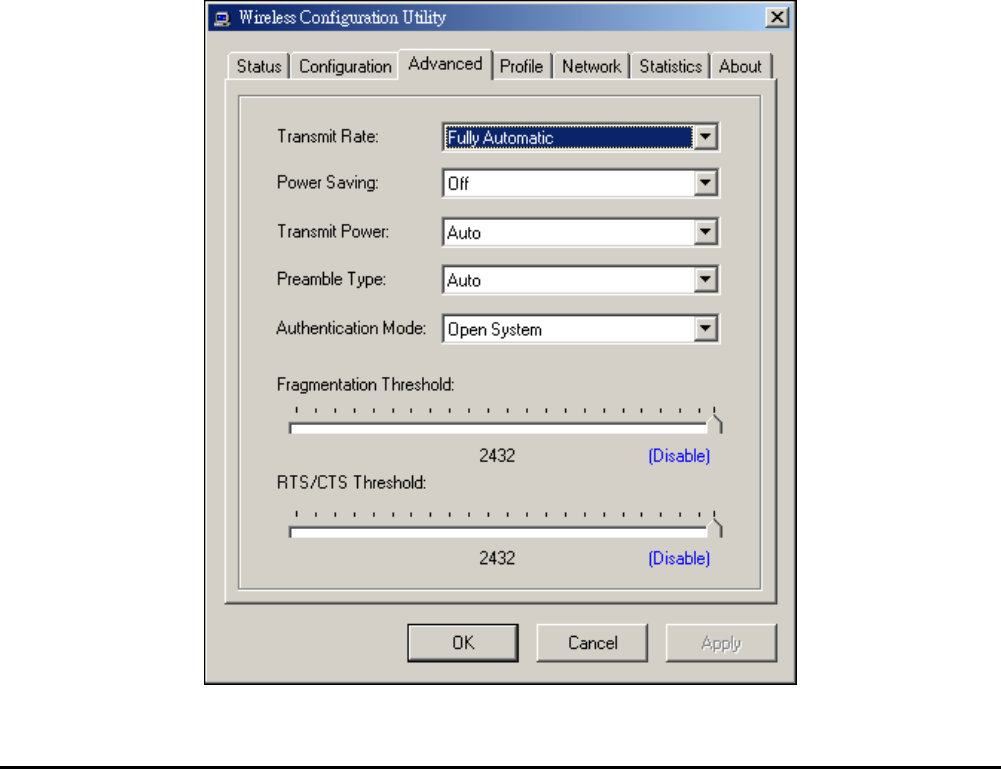
12
If you select 256bit in Hex format, you must type 58 values (0~F,
hexadecimal), or 256bit in ASCII format, you must type 29 values in
the following range (0~9, A~Z and a~z Alphanumeric).
Be sure that the Cardbus Adapter and the wireless station was set in
the same key.
¾ Create with Passphrase:
The Passphrase in the dialog box helps you to create a group of WEP
key in the Key Setting, while input a phrase in the Passphrase dialog,
you can see the group of key setting will be changed.
Note: After all the settings are completed, click Apply to save the setting.
Advanced
The Advanced settings help you to control the Cardbus Adapter to
adjust with wireless devices in certain environment.

13
¾ Transmit Rate:
You can choose one of the transmission rates as follows, 54Mbps,
48Mbps, 36Mbps, 24Mbps, 22Mbps, 18Mbps, 12Mbps, 11Mbps,
9Mbps, 6Mbps, 5.5Mbps, 2Mbps, 1Mbps, Fully Automatic and Turbo
Mode.
In some specific wireless devices, the transmit rate can define up to
72Mbps for 802.11g, select the Turbo Mode function to enhance the
transfer rate of the wireless connection.
The Fully Automatic and Turbo Mode will automatically detect the
suitable linking transfer rate and auto fall back when the signal is not
too strong to transmit data.
¾ Power Saving:
To set your Wireless Cardbus Adapter as power saving mode, select
“Off”, “Normal” or “Maximum”.
¾ Transmit Power:
By selecting the Transmit Power, you can select the Radio Frequency
output power from Minimum, 12.5%, 25%, 50%,100% or Auto.
¾ Preamble Type:
The usage of the preamble is to limit the packet size of the data to
transmit. It is recommended to choose the short preamble when the
link quality is bad, it is to prevent the wasting time of resending a long
packet that is lost. The Default is Auto which access short and long
preamble.

14
¾ Authentication Type:
Open System: with the same WEP key between the stations, the
stations don’t need to be authenticated, and this algorithm was set to
default.
Shared Key: with the same WEP key between the stations in this
Authentication algorithm, this type will use packets with encryption
by transferring a challenge text which will be acknowledge by both
side of the stations. In order to choose which authentication algorithm
will be used, you must know which one the station supports this
algorithm first.
¾ Fragment Threshold:
Fragmentation Threshold is a way of transmitting the packets that will
be fragmented. Choose a setting within a range of 256 to 2432. It is
recommended to fragment the packet when the link quality is bad, it is
to prevent the wasting time of resending a long packet that is lost.
¾ RTS/CTS Threshold:
The RTS/CTS Threshold is a station initiates the process by sending a
RTS frame, the other ends receives the RTS and responds with a CTS
frame, the station must receive a CTS frame before sending the data
frame. This is to prevent the collisions by each station. Choose a
setting within a range of 256 to 2432. It is recommended limiting a
long packet to prevent each station waiting too long to transmit a data.
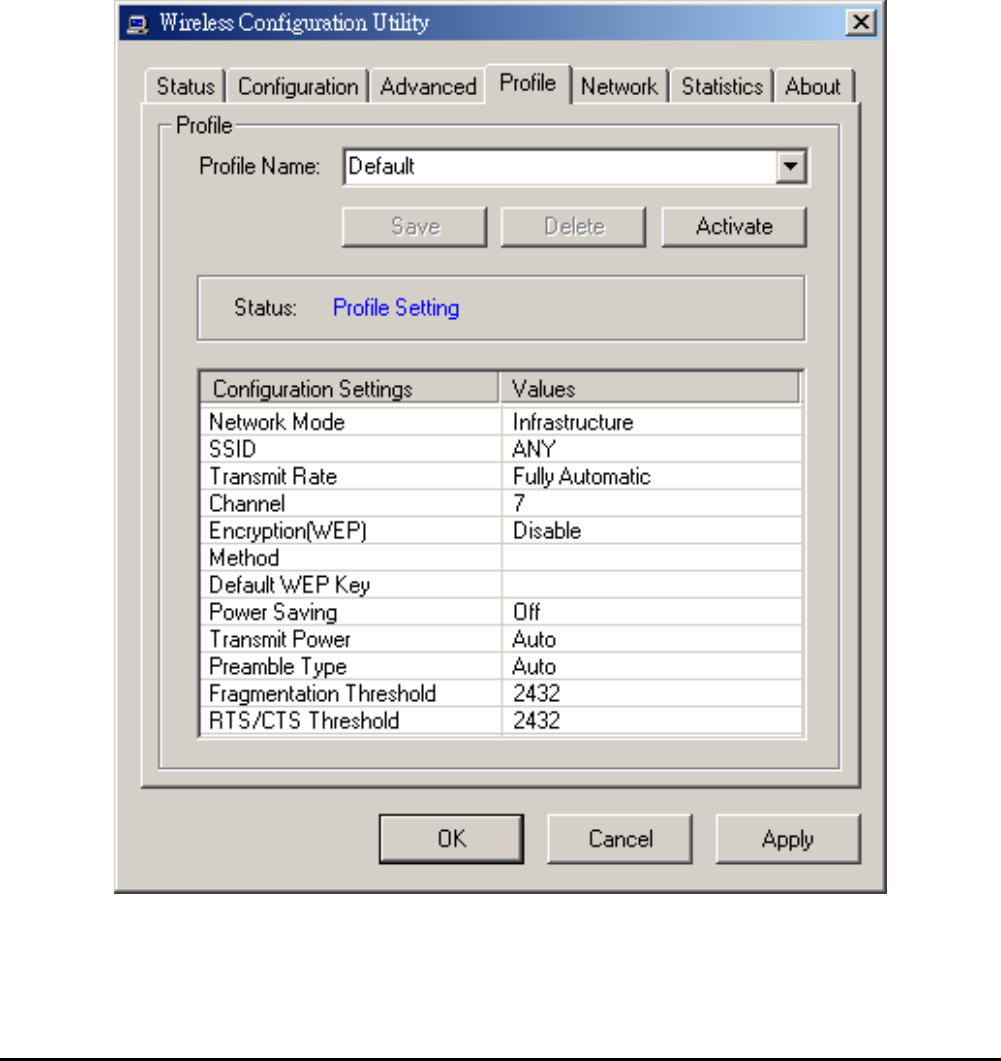
15
Profile
The Profile section allows you to set values for all parameters by
selecting a previously defined profile. Type a name in the Profile
Name field to create a profile, click Save and click Apply when a
profile is done. You can click Delete if the profile is no longer used, to
activate other profile, choose a profile name in the Profile Name field
and click Activate.
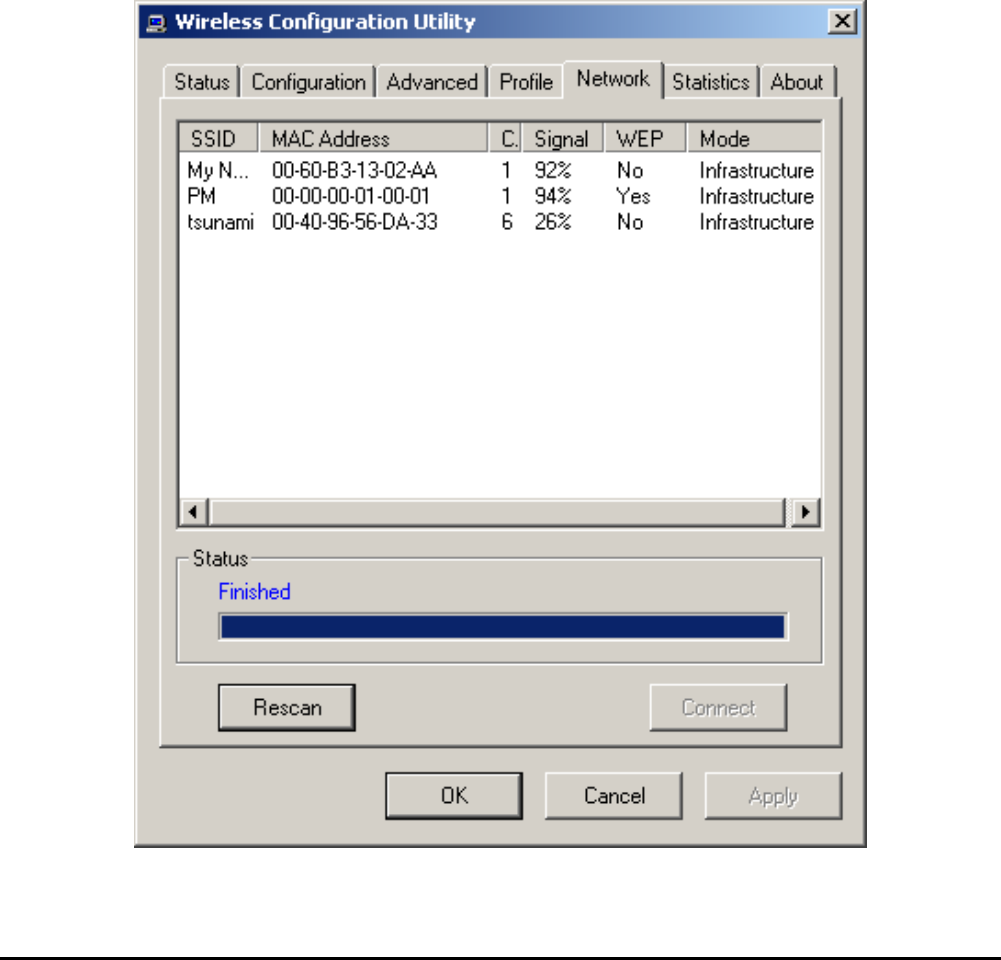
16
Network
The screen shows all the Wireless devices around your Wireless
Cardbus Adapter. The information of the wireless devices includes the
SSID, MAC Address, Channels, Signal, the WEP type and the
Network mode.
You can click the Rescan button to find the new wireless devices, and
double-click the device to choose the wireless station that you want to
connected with.
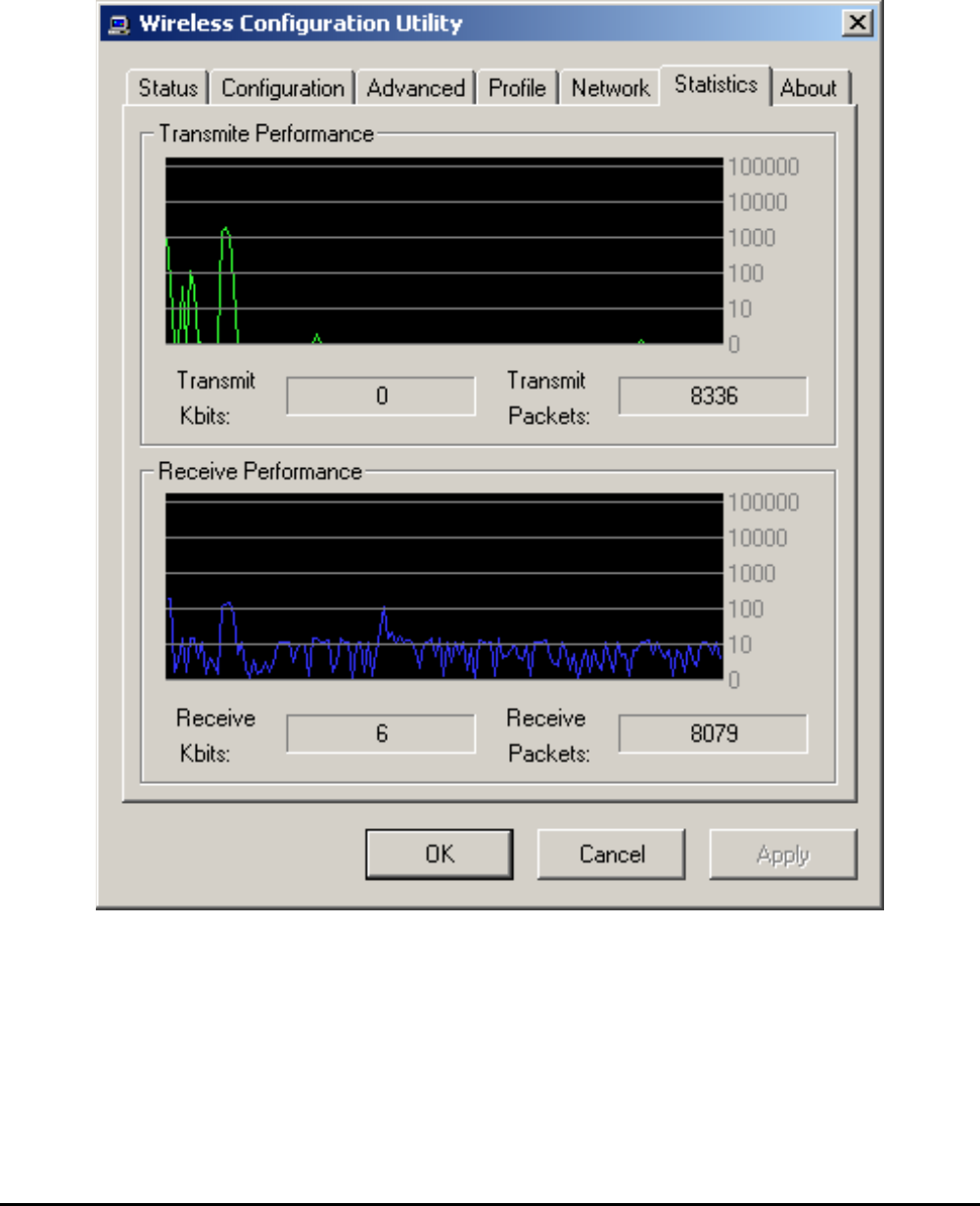
17
Statistic
The Statistic section shows the real-time transmit and receive packets
of the Cardbus Adapter.
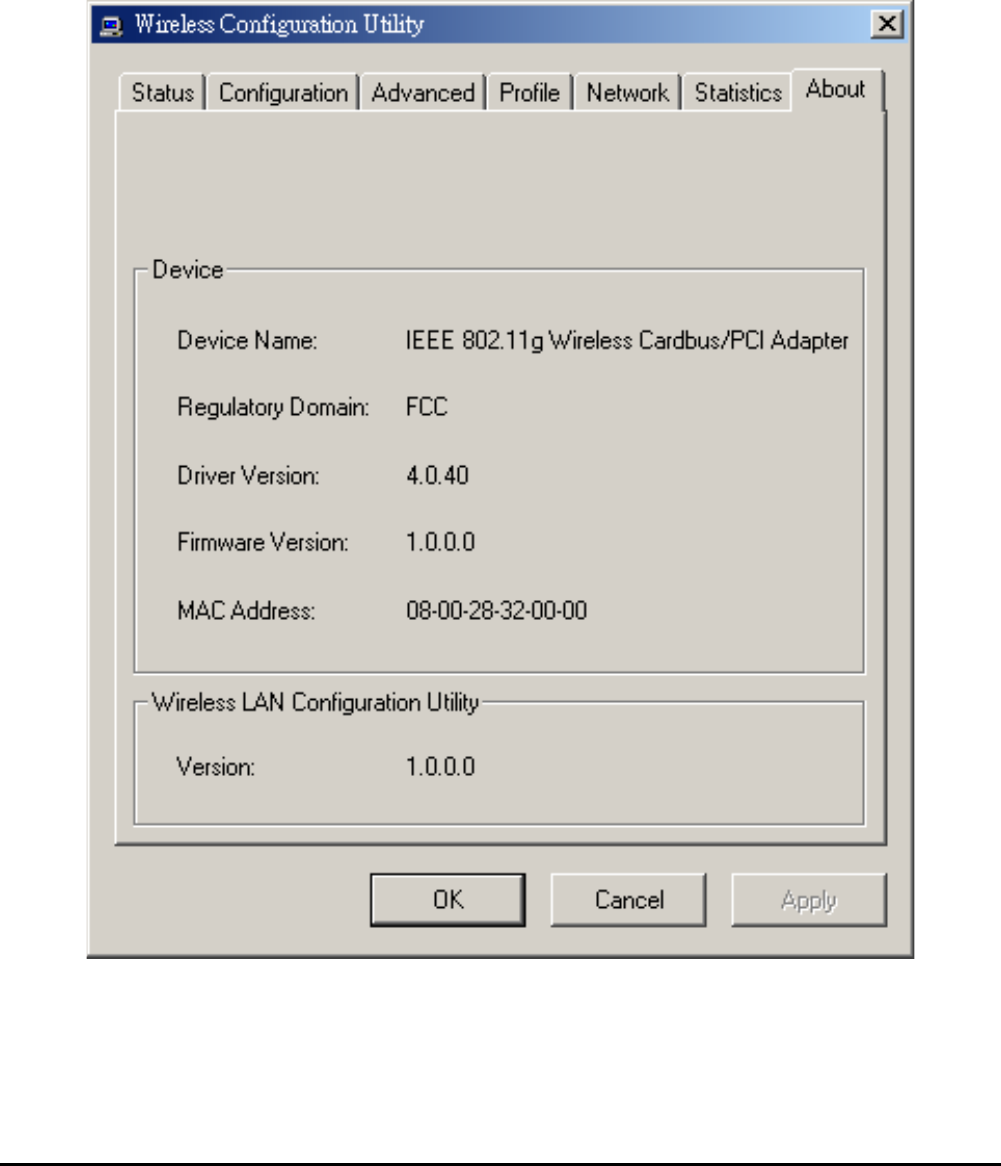
18
About
The About section shows the Device Name, Regulatory Domain,
Driver Version, Firmware Version, MAC Address and the Utility
version.
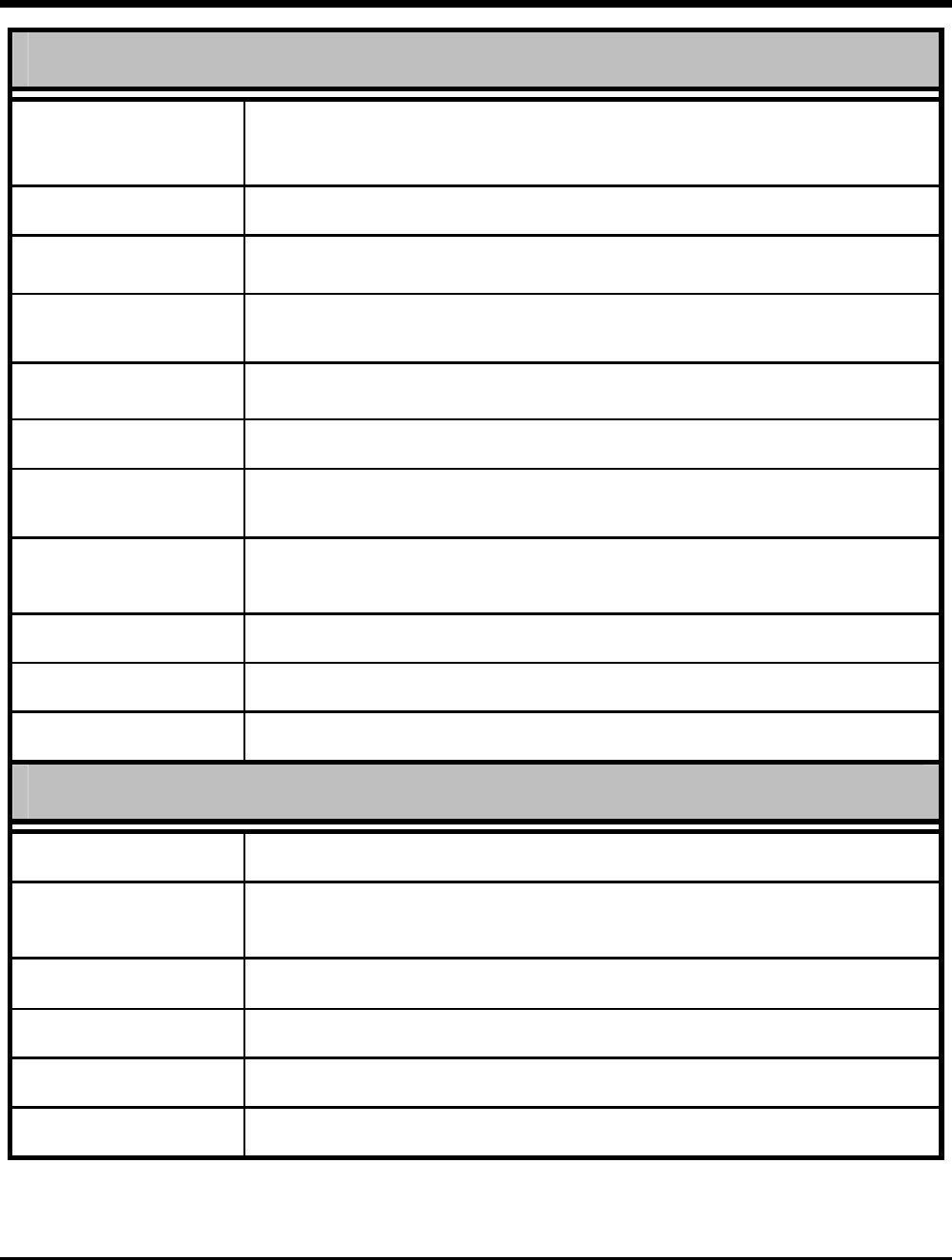
19
TECHNICAL SPECIFICATIONS
General
Radio Technology IEEE 802.11b Direct Sequence Spread Spectrum (DSSS)
IEEE 802.11g Orthogonal Frequency Division Multiplexing (OFDM)
Interface CardBus Type II specification 32bit data bus
Data Transfer Rate 1, 2, 5.5, 6, 9, 11, 12, 18, 24, 36, 48, 54Mbps (auto sense)
Receiver Sensitivity 54Mbps: Typical -72dBm @ 8% PER (Packet Error Rate)
11Mbps: Typical -85dBm @ 8% PER (Packet Error Rate)
Frequency Range 2400 ~ 2497 MHz ISM band (channels 1 ~ 14)
Modulation Schemes DBPSK/DQPSK/CCK/OFDM
Channels 1~11 channels (FCC), 1~13 channels (ETSI), 1~14 channels (MKK-
Japan), 10~13 channels (France), 3~9 channels (Israel)
Media Access
Protocol CSMA/CA with ACK
Security 64/128/256-bits WEP Encryption, WPA
Diagnostic LED PWR (Power) & LNK (Link status)
Antenna Integrated Microstrip dual diversity antennas
Physical and Environmental
Driver Support Windows 98, Windows 2000, Windows ME, Windows XP
Continuous Current
Consumption 480mA typ. for receive mode, 650mA typ. for transmit mode
Temperature Operating: 0q ~ 40q C, Storage: -25q ~ 70q C
Humidity 10% ~ 95% RH, no condensation
Dimensions 118 x 54 x 7 mm (W x H x D)
Certifications FCC Part 15.247 for US, ETS 300 328 for Europe,
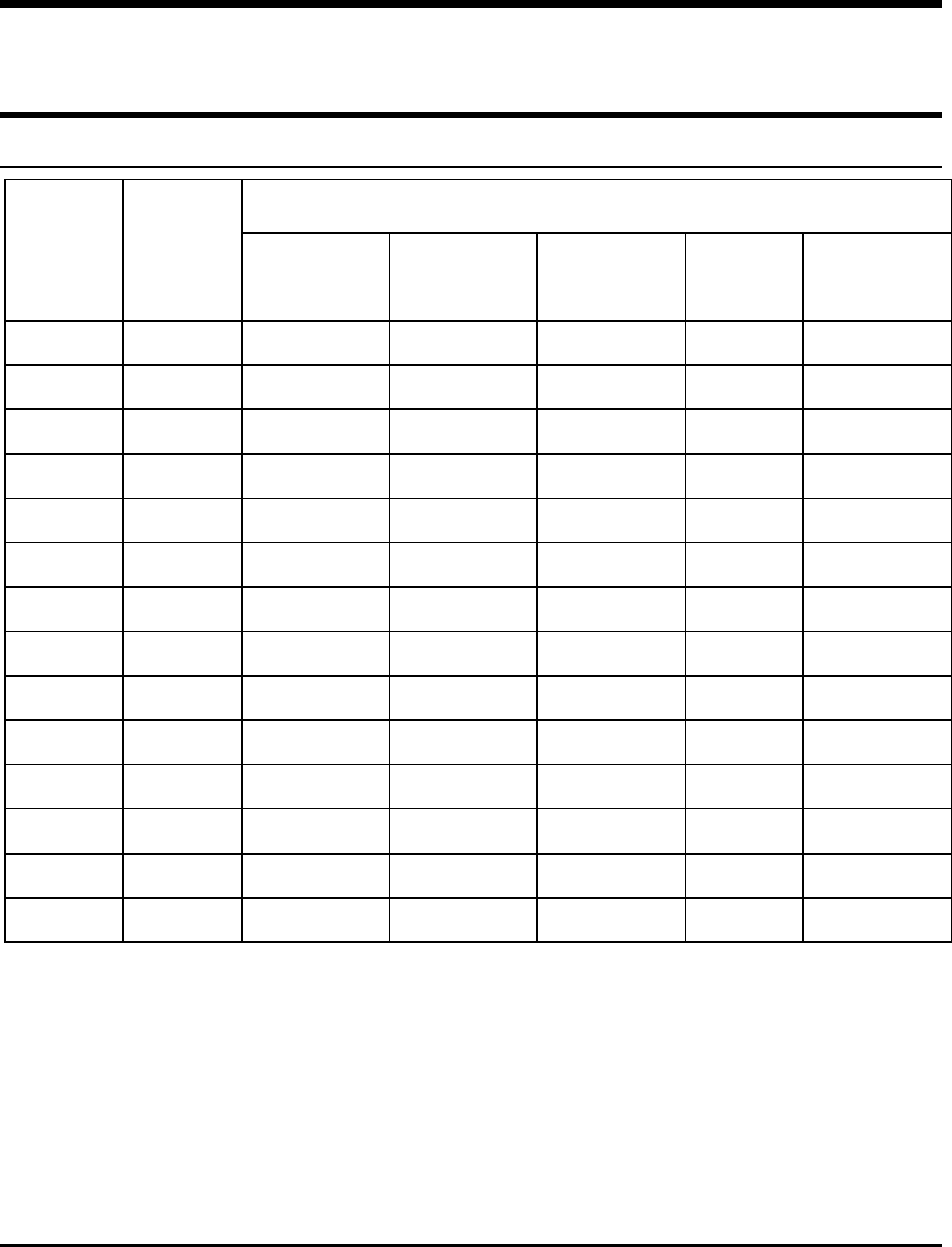
21
APPENDIX A
This appendix lists the IEEE 802.11g channels supported by the
world’s regulatory domains.
Regulatory Domains
Regulatory Domains Channel
Identifier
802.11b
Frequency
FCC (North
America)
ETSI (Europe) France Israel MKK (Japan)
1 2412 X X X
2 2417 X X X
3 2422 X X X X
4 2427 X X X X
5 2432 X X X X
6 2437 X X X X
7 2442 X X X X
8 2447 X X X X
9 2452 X X X X
10 2457 X X X X
11 2462 X X X X
12 2467 X X X
13 2472 X X X
14 2484 X
For some European Country, it may have its own domain, users are
responsible for ensuring that the channel set configuration is in
compliance with the regulatory standards of these countries.

APPENDIX B
22
Warning Statement
CAUTION:
Any changes or modifications not expressly approved by the party responsible for compliance could void
the user’ s authority to operate the equipment.
PROHIBITION OF CO-LOCATION
This device and its antenna(s) must not be co-located or operating in conjunction with any other antenna or
transmitter.
FEDERAL COMMUNICATIONS COMMISSION REQUIREMENTS
This equipment has been tested and found to comply with the limits for a class B digital device, pursuant to
part 15 of the FCC Rules. These limits are designed to provide reasonable protection against harmful
interference in a residential installation.
This equipment generates, uses and can radiate radio frequency energy and, if not installed and used in
accordance with the instructions, may cause harmful interference to radio communications. However,
there is no guarantee that interference will not occur in a particular installation. If this equipment does
cause harmful interference to radio or television reception, which can be determined by turning the
equipment off and on, the user is encouraged to try to correct the interference by one or more of the
following measures:
---Reorient or relocate the receiving antenna.
---Increase the separation between the equipment and receiver.
---Connect the equipment into an outlet on a circuit different from that to which the receiver is connected.
---Consult the dealer or an experienced radio/TV technician for help.